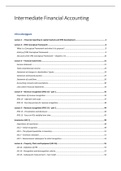Summary
Summary/samenvatting Intermediate Financial Accounting
- Course
- Institution
- Book
It is a very extensive summary of the lecture notes of Intermediate Financial Accounting (IFA). Includes many of examples which will help for the preparation of the exam.
[Show more]




